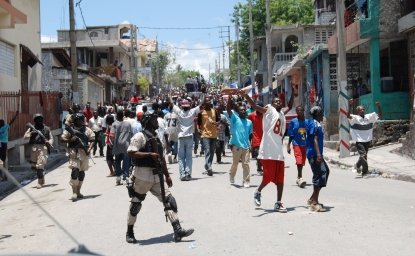Hosni Mubarak, who died Tuesday, February 25 at 91, came to power under dramatic circumstances and was overthrown in equally dramatic ones. In between, he ruled Egypt for thirty years with a steady hand, only to leave behind myriad problems that now threaten to overwhelm his Nile Valley nation.
Mubarak became president of the Arab world’s most populous country in the wake of President Anwar Sadat’s assassination by Islamic extremists in 1981. It happened during a military parade in Cairo marking the start of the 1973 Arab-Israeli war on October 6. I had just arrived four months earlier to begin reporting on the Middle East for the Washington Post. There I was, in the military stand sitting less than fifty yards above him when the killers opened fire from a jeep towing a piece of artillery. The jeep had stopped right in front of the podium, and behind and above it Sadat was seated. The assassins then jumped out of the jeep and ran up to the stand spraying bullets from their AK-47 rifles onto other Egyptian officials who had been sitting around him. One of them was Hosni Mubarak, Sadat’s vice president.
As the Islamist terrorists opened fire I sat petrified and unbelieving at what was happening before my eyes. Pandemonium broke out among the assembly of Egyptian and foreign guests, and my first thought was whether it was better to stay standing or lie down to escape the bullets. I didn’t want to get trampled so I remained up. Then I decided to run down to the podium to see whether Sadat was still alive. There was so much confusion that I was able to get down to the podium only to discover Sadat had been whisked away. We would not learn until that afternoon that he had died – probably on the way to the hospital.
Egyptian security officials had thrown the dignitaries down on the stand and covered them with chairs as scant protection from the gunfire. Getting up from under one pile of chairs was Mubarak, dusting off his military kepi hat that I heard later had a bullet hole through it. That was how close Mubarak came to death along with Sadat that day, how close he had been to never ruling Egypt.
Getting up from under one pile of chairs was Mubarak, dusting off his military kepi hat that I heard later had a bullet hole through it. That was how close Mubarak came to death along with Sadat that day, how close he had been to never ruling Egypt.
Mubarak had risen through the ranks of the air force to become its commander but was otherwise an unknown entity. Egyptians who love to make jokes about their leaders called him “La Vache Qui Rit,” French for “The Laughing Cow” which appeared on the round boxes of French cheese on sale everywhere in Egypt. He had no agenda or vision for Egypt’s future other than rooting out cells of several Islamic groups behind Sadat’s assassination. In that task he thoroughly succeeded, using police state tactics to suppress any move toward democracy until President George W. Bush prevailed upon him to hold semi-free parliamentary elections in 2005.
During the four years I lived in Cairo, Mubarak made little news while the Israeli invasion of Lebanon (starting in June 1982) consumed the attention of the world and the American media. Mubarak kept his head down and maintained peace with Israel, albeit a cold one. But he paid no attention to the mounting social and economic problems under which Egypt was slowly submerging. He realized the population explosion was a major concern – the 100 millionth Egyptian child was born on February 11 this year – and he tried to launch a family planning program that eventually failed.
The Egyptian education system was already a disaster, with parents forced to pay teachers for private lessons if they wanted their children to make it into one of the country’s overcrowded universities. The Nile River’s life-giving waters were threatened by a huge dam that Ethiopia was planning at its source. But Mubarak had paid no attention to Egypt’s relations with Africa, and his relations with Ethiopia’s rulers turned icy after an attempt on his life while visiting Addis Ababa in June 1995.
Mubarak’s downfall came about in as dramatic a fashion as his ascent to power, though it took eighteen days rather than a few hours. This time however, he was the cause of his own demise. He wanted to shoehorn his son, Gamal, into the presidency after he retired. But unlike his father, Gamal had never been an officer and had not courted the military, which detested him. Instead, he used the National Democratic Party to try to win elections that were scheduled for the fall of 2011.
Mubarak’s downfall came about in as dramatic a fashion as his ascent to power, though it took eighteen days rather than a few hours.
When demonstrations broke out in Cairo on January 25, 2011, Mubarak did not take the threat seriously even though Tunisian President Zine al-Abidin Ben Ali had already been overthrown by street protests. He didn’t take seriously, either, a Tunisian military statement issued six days later recognizing “the legitimacy of the people’s demands” and promising not to use force “against this great people.” One of his advisors tried to scare him into resigning, telling him he was facing a “Ceausescu moment,” if he didn’t. (Nicolae Ceausescu was Romania’s last communist leader executed by firing squad in that country’s 1989 uprising.)
Still, Mubarak didn’t believe he was in danger. But the military insisted he was and forced him to transfer power to the Supreme Council of the Armed Forces which on the morning of February 11, flew him and his family to his home in Sharm el-Sheikh on the Red Sea. From then on, it was one trial after another for his various alleged crimes. In the end, he escaped a death sentence and was eventually freed to die quietly in a Cairo hospital.
One of his main legacies seems paradoxical. After suppressing the rise of Islamists to power for three decades, events after his removal would lead to the election of Muslim Brotherhood leader, Mohammed Morsi in June 2012. Morsi was the first elected Islamist leader in Egypt’s 6,000-year-old history, but was deposed in a military coup that claimed legitimacy from a public uprising against the Brotherhood’s leadership. Now Egypt is in the full pendulum swing of counterrevolution, executed by President Abdel Fattah al-Sisi with the same determination that Mubarak showed in order to root out the Islamists that killed Sadat in 1981 and threatened his own life.
One of his main legacies seems paradoxical. After suppressing the rise of Islamists to power for three decades, events after his removal would lead to the election of Muslim Brotherhood leader, Mohammed Morsi in June 2012.
However, as Egypt’s longest, yet uninspired and uninspiring ruler for 30 years, Mubarak had the most opportunities to address Egypt’s pressing demographic and economic challenges. But In the fashion of a military officer, he adhered to a strict mandate to maintain stability and suppress unrest and Islamist agitation. On social and economic matters, Mubarak lent only a tin ear to international consultants, foreign leaders and economic experts urging him to press forward with various reforms he found too risky. In the end, the Mubarak 30-year status quo proved costly for the Nile Valley country, now 100 million strong and struggling to cope with its social, economic and political problems. Egypt is now badly in need of a dynamic and innovative leadership that can guide the largest country in the Arab world to a prosperous future.
The views expressed in this article are those of the author and do not reflect an official position of the Wilson Center.
Author

Former Washington Post Middle East Correspondent

Middle East Program
The Wilson Center’s Middle East Program serves as a crucial resource for the policymaking community and beyond, providing analyses and research that helps inform US foreign policymaking, stimulates public debate, and expands knowledge about issues in the wider Middle East and North Africa (MENA) region. Read more

Explore More
Browse Insights & Analysis
MENA360°

Greenland’s New Governing Coalition Signals Consensus


